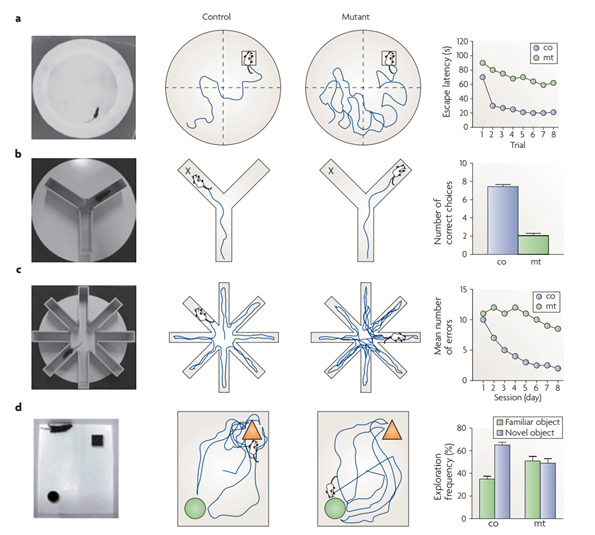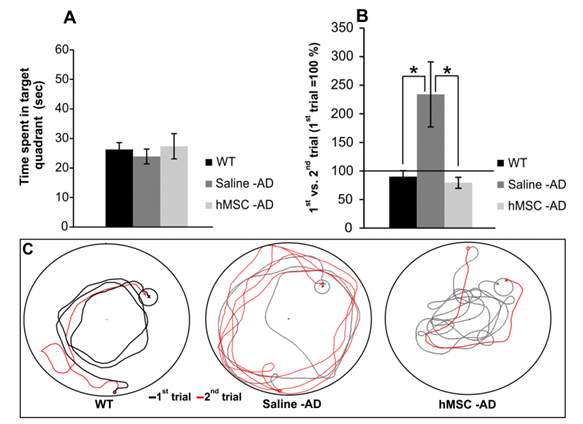Cognitive Function Tests
Irreversible cognitive impairment is one of the most obvious pathological features of Alzheimer's disease, and currently there are still no curative therapies available for Alzheimer's disease. Creative Bioarray offers extensive cognitive assays to evaluate the effects of preclinical drug candidates on their effects in cognitive functions formation. We also evaluate drug candidates in learning, memory formation and during amnesia.
 Figure.1. Behavioural tests used to assess memory functions in AD mouse models. (a) The Morris water maze measures spatial reference memory. (b) The Y‑maze measures spatial working memory. (c) The radial arm maze measures short‑term working memory. (d) In the novel object recognition test the mouse is placed in an enclosure where it is exposed to two objects for a defined time.
Figure.1. Behavioural tests used to assess memory functions in AD mouse models. (a) The Morris water maze measures spatial reference memory. (b) The Y‑maze measures spatial working memory. (c) The radial arm maze measures short‑term working memory. (d) In the novel object recognition test the mouse is placed in an enclosure where it is exposed to two objects for a defined time.
Creative Bioarray provides cognitive function tests including but not limited to:
- Morris Water Maze Test
- Y-Maze Test
- Novel Object Recognition Test
- Barnes Maze Test
- Passive and Active Avoidance Test
- Contextual Fear Conditioning Test
- Two Choice Swim Test
- Open field test
Our extensive experience supports the most comprehensive cognitive function tests to bolster your screening of compounds aimed to treat Alzheimer's disease. Our experts make every effort to design optimized and specific projects to serve our clients.
Study examples
 Figure 2. Results from the Morris water maze (MWM) test (probe trial) showing that reference memory was maintained in non-transgenic and transgenic mice at 14 months of age (A) In the working memory test, the percentages shown on the y-axis indicate what percent of the time needed to find the hidden platform was saved between the first and second trials; 100% indicates no difference between the two trials (B) Illustrative images of mouse trajectories in the MWM during the first and second trials used for working memory assessment (C). * p < 0.05. WT: wild-type; AD: Alzheimer’s disease; hMS: human mesenchymal stem cell.
Figure 2. Results from the Morris water maze (MWM) test (probe trial) showing that reference memory was maintained in non-transgenic and transgenic mice at 14 months of age (A) In the working memory test, the percentages shown on the y-axis indicate what percent of the time needed to find the hidden platform was saved between the first and second trials; 100% indicates no difference between the two trials (B) Illustrative images of mouse trajectories in the MWM during the first and second trials used for working memory assessment (C). * p < 0.05. WT: wild-type; AD: Alzheimer’s disease; hMS: human mesenchymal stem cell.
Quotation and ordering
If you have any special needs or questions regarding our services, please feel free to contact us. We look forward to cooperating with you in the future.
References
- Götz, J et al. Animal models of Alzheimer's disease and frontotemporal dementia. Nat Rev Neurosci, 2008, 9(7): 532-544.
- Ruzicka J et al. Mesenchymal Stem Cells Preserve Working Memory in the 3xTg-AD Mouse Model of Alzheimer’s Disease. International Journal of Molecular Sciences. 2016; 17: 152.
For research use only. Not for any other purpose.
Disease Models
- Oncology Models
-
Inflammation & Autoimmune Disease Models
- Rheumatoid Arthritis Models
- Glomerulonephritis Models
- Multiple Sclerosis (MS) Models
- Ocular Inflammation Models
- Sjögren's Syndrome Model
- LPS-induced Acute Lung Injury Model
- Peritonitis Models
- Passive Cutaneous Anaphylaxis Model
- Delayed-Type Hypersensitivity (DTH) Models
- Inflammatory Bowel Disease Models
- Systemic Lupus Erythematosus Animal Models
- Oral Mucositis Model
- Asthma Model
- Sepsis Model
- Psoriasis Model
- Atopic Dermatitis (AD) Model
- Scleroderma Model
- Gouty Arthritis Model
- Carrageenan-Induced Air Pouch Synovitis Model
- Carrageenan-Induced Paw Edema Model
- Experimental Autoimmune Myasthenia Gravis (EAMG) Model
- Graft-versus-host Disease (GvHD) Models
-
Cardiovascular Disease Models
- Surgical Models
- Animal Models of Hypertension
- Venous Thrombosis Model
- Atherosclerosis model
- Cardiac Arrhythmia Model
- Hyperlipoidemia Model
- Doxorubicin-induced Heart Failure Model
- Isoproterenol-induced Heart Failure Model
- Arterial Thrombosis Model
- Pulmonary Arterial Hypertension (PAH) Models
- Heart Failure with Preserved Ejection Fraction (HFpEF) Model
-
Neurological Disease Models
- Alzheimer's Disease Modeling and Assays
- Seizure Models
- Parkinson's Disease Models
- Ischemic Stroke Models
- Acute Spinal Cord Injury (ASCI) Model
- Traumatic Brain Injury (TBI) Model
- Hypoxic-Ischemic Encephalopathy (HIE) Model
- Tourette Syndrome (TS) Model
- Amyotrophic Lateral Sclerosis (ALS) Model
- Huntington's Disease (HD) Model
- Intracerebral hemorrhage (ICH) Models
- Schizophrenia Model
- Pain Models
-
Metabolic Disease Models
- Type 1 Diabetes Mellitus Model
- Type 2 Diabetes Mellitus Model
- Animal Model of Hyperuricemia
-
Nonalcoholic Fatty Liver Disease Model
- High-Fat Diet-Induced Nonalcoholic Fatty Liver Disease (NAFLD) Model
- Methionine and Choline Deficient (MCD) Diet-Induced Nonalcoholic Fatty Liver Disease (NAFLD) Model
- Gubra-Amylin NASH (GAN) Diet-Induced Nonalcoholic Fatty Liver Disease (NAFLD) Model
- Streptozotocin (STZ) Induced Nonalcoholic Fatty Liver Disease (NAFLD) Model
- High Fat Diet-Induced Obesity Model
- Diabetic Foot Ulcer (DFU) Model
- Liver Disease Models
- Rare Disease Models
- Respiratory Disease Models
- Digestive Disease Models
-
Urology Disease Models
- Cisplatin-induced Nephrotoxicity Model
- Unilateral Ureteral Obstruction Model
- 5/6 Nephrectomy Model
- Renal Ischemia-Reperfusion Injury (RIRI) Model
- Diabetic Nephropathy (DN) Models
- Passive Heymann Nephritis (PHN) Model
- Adenine-Induced Chronic Kidney Disease (CKD) Model
- Kidney Stone Model
- Doxorubicin-Induced Nephropathy Model
- Orthotopic Kidney Transplantation Model
- Orthopedic Disease Models
- Ocular Disease Models
- Skin Disease Models
- Infectious Disease Models
- Otology Disease Models